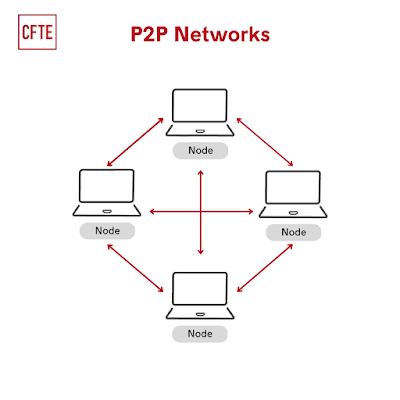Peer-to-Peer Network
In a peer-to-peer (P2P) network, there is no central server. Instead, each device (or "peer") in the network can act as both a client and a server, directly sharing resources with other peers. This means each device can request resources from and provide resources to other devices on the network.
Key Features of Peer-to-Peer Networks
Decentralized Structure: Unlike client-server networks, where a central server manages resources, P2P networks are decentralized. Every peer has equal authority, meaning there’s no single point of control.
Direct Communication: Peers communicate directly with each other, sharing resources like files, applications, or network bandwidth without needing an intermediary server.
Resource Sharing: In a P2P network, resources such as files, processing power, and storage space are shared among the devices, making it highly collaborative. Each peer contributes part of its resources, benefiting the entire network.
How Peer-to-Peer Networks Work
In a P2P network, each device is connected to other devices directly, allowing them to share resources as needed. When a peer wants a particular resource (such as a file), it searches for other peers that have it. Once located, the resource is downloaded directly from that peer. For instance, in file-sharing networks, parts of a file might be downloaded from multiple peers simultaneously, which speeds up the process.
Advantages of Peer-to-Peer Networks
Cost-Effective: P2P networks don’t require a central server, making setup and maintenance more affordable, especially for small networks.
Fault Tolerance: Since resources are distributed across multiple devices, the failure of one peer doesn’t disrupt the entire network. Other peers can still continue sharing resources.
Scalability: P2P networks can grow easily as new devices are added, each contributing resources to the network.
Efficient File Distribution: In a P2P file-sharing network, multiple peers can download parts of the same file simultaneously from different devices, making the transfer faster and reducing strain on a single peer.
Disadvantages of Peer-to-Peer Networks
Security Concerns: Without centralized control, enforcing security policies across all peers is challenging. P2P networks can be more vulnerable to security risks, as each device is responsible for its own security.
Limited Control and Management: The lack of a central server makes it harder to monitor, manage, or control network activities, especially in large P2P networks.
Performance Issues: The performance of a P2P network can depend on the quality and availability of resources from individual peers. If some peers are slow or disconnected, network performance may drop.
Data Integrity: In some P2P networks, it can be difficult to ensure data integrity and consistency because files are often shared across multiple peers.
Examples of Peer-to-Peer Networks
File Sharing Applications: Popular file-sharing platforms like BitTorrent use P2P networking to share large files among users, with each user downloading from and uploading to other users.
Blockchain and Cryptocurrencies: Blockchain networks, like those used for Bitcoin, are decentralized P2P networks where each peer maintains a copy of the blockchain and validates transactions.
Messaging Apps: Some messaging apps (such as older versions of Skype) use P2P networking to facilitate direct communication between users without relying on central servers.



Comments
Post a Comment